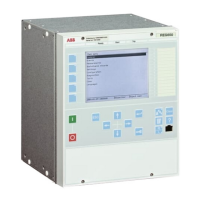Pole discordance protection CCRPLD
Circuit breakers and disconnectors can end up with the phases
in different positions (close-open), due to electrical or
mechanical failures. An open phase can cause negative and
zero sequence currents which cause thermal stress on rotating
machines and can cause unwanted operation of zero sequence
or negative sequence current functions.
Normally the own breaker is tripped to correct such a situation.
If the situation persists the surrounding breakers should be
tripped to clear the unsymmetrical load situation.
The pole discordance function operates based on information
from the circuit breaker logic with additional criteria from phase
selective current unsymmetry.
Directional over/underpower protection GOPPDOP/
GUPPDUP
The directional over-/under-power protection GOPPDOP/
GUPPDUP can be used wherever a high/low active, reactive or
apparent power protection or alarming is required. The
functions can alternatively be used to check the direction of
active or reactive power flow in the power system. There are a
number of applications where such functionality is needed.
Some of them are:
• detection of reversed active power flow
• detection of high reactive power flow
Each function has two steps with definite time delay.
Accidental energizing protection for synchronous generator
AEGGAPC
Inadvertent or accidental energizing of off-line generators has
occurred often enough due to operating errors, breaker head
flashovers, control circuit malfunctions, or a combination of
these causes. Inadvertently energized generator operates as
induction motor drawing a large current from the system. The
voltage supervised overcurrent protection is used to protect the
inadvertently energized generator.
Accidental energizing protection for synchronous generator
(AEGGAPC) takes the maximum phase current input from the
generator terminal side or generator neutral side and maximum
phase to phase voltage inputs from the terminal side.
AEGGAPC is enabled when the terminal voltage drops below
the specified voltage level for the preset time.
Negative sequence time overcurrent protection for machines
NS2PTOC
Negative-sequence time overcurrent protection for machines
NS2PTOC is intended primarily for the protection of generators
against possible overheating of the rotor caused by negative
sequence current in the stator current.
The negative sequence currents in a generator may, among
others, be caused by:
• Unbalanced loads
• Line to line faults
• Line to earth faults
• Broken conductors
• Malfunction of one or more poles of a circuit breaker or a
disconnector
NS2PTOC can also be used as a backup protection, that is, to
protect the generator in case line protections or circuit breakers
fail to clear unbalanced system faults.
To provide an effective protection for the generator for external
unbalanced conditions, NS2PTOC is able to directly measure
the negative sequence current. NS2PTOC also has a time delay
characteristic which matches the heating characteristic of the
generator
as defined in standard IEEE C50.13.
where:
I
2
is negative sequence current expressed in
per unit of the rated generator current
t is operating time in seconds
K is a constant which depends of the
generators size and design
NS2PTOC has a wide range of
K
settings and the sensitivity and
capability of detecting and tripping for negative sequence
currents down to the continuous capability of a generator.
In order to match the heating characteristics of the generator a
reset time parameter can be set.
A separate definite time delayed output is available as an alarm
feature to warn the operator of a potentially dangerous
situation.
Voltage-restrained time overcurrent protection VRPVOC
Voltage-restrained time overcurrent protection (VRPVOC)
function is recommended as a backup protection for
generators.
The overcurrent protection feature has a settable current level
that can be used either with definite time or inverse time
characteristic. Additionally, it can be voltage controlled/
restrained.
One undervoltage step with definite time characteristic is also
available within the function in order to provide functionality for
overcurrent protection with undervoltage seal-in.
Rotor earth fault protection
Generator rotor winding and its associated dc supply electric
circuit is typically fully insulated from the earth. Therefore single
connection of this circuit to earth will not cause flow of any
substantial current. However, if second earth-fault appears in
this circuit circumstances can be quit serious. Depending on
the location of these two faults such operating condition may
cause:
Generator protection REG650
1MRK 502 050-BEN B
Product version: 1.3
16 ABB

